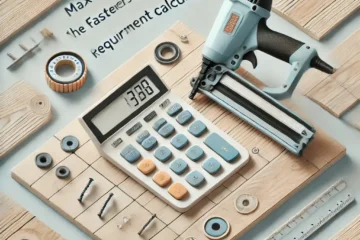The Nail Penetration Calculator is a practical tool designed for DIY enthusiasts, carpenters, and construction professionals.
Nail Penetration Calculator
Nail Penetration Calculator
It allows you to estimate how far a nail can penetrate into a material based on specific parameters like the nail gun’s power, the nail’s dimensions, and the density of the material.
Whether you’re working on a woodworking project, installing drywall, or engaging in other construction tasks, this calculator can provide valuable insights to ensure the job is done right.
How the Nail Penetration Calculator Works
The calculator uses basic physics principles to estimate nail penetration. It takes into account the following inputs:
- Power (in Joules): This represents the energy output of the nail gun. Higher power typically results in deeper penetration.
- Nail Diameter (in mm): The diameter of the nail affects its resistance against the material. Thicker nails require more force to penetrate.
- Material Density (in kg/m³): This refers to the density of the material you’re nailing into. For example, denser materials like hardwood or metal will resist nail penetration more than softer materials like pine or foam.
- Nail Length (in mm): This is the total length of the nail. The calculator ensures that the penetration depth does not exceed the nail’s total length.
The calculator then performs the following calculations:
- It calculates the cross-sectional area of the nail using its diameter.
- It estimates the force exerted by the nail gun.
- It calculates the resistance of the material based on its density and the nail’s cross-sectional area.
- Finally, it estimates the penetration depth by dividing the force by the material resistance, converting it to millimeters, and ensuring that it doesn’t exceed the nail’s total length.
Why Use the Nail Penetration Calculator?
- Accurate Estimations: This tool helps you estimate how deep a nail will penetrate based on the specific project parameters. It saves you from trial-and-error and potential mistakes.
- Project Planning: By understanding the penetration depth, you can select the right nail length and power settings for your nail gun, ensuring secure fastening without damaging materials.
- Versatility: The calculator works for a variety of materials, from wood and drywall to denser materials like concrete or metal, making it a versatile tool for different construction projects.
- Safety: Knowing the penetration depth in advance can help prevent accidents, such as over-penetration that could cause damage to the material or pose a safety hazard to workers.
Tips for Using the Nail Penetration Calculator
- Know Your Materials: Before using the calculator, make sure to accurately identify the material you’re working with. Materials like hardwood and metal require more force for proper penetration compared to softer woods or drywall. Use accurate density values for better estimations.
- Choose the Right Nail: The length and diameter of the nail are crucial factors. Using a nail that is too short may result in weak fastening, while a nail that is too long might cause over-penetration. Select the right nail for your specific material and project needs.
- Check Your Nail Gun Settings: Different nail guns have varying power outputs. Make sure to know the power of your nail gun in joules to enter the correct value. This will help you avoid under- or over-driving nails.
- Consider Environmental Factors: Keep in mind that factors like humidity or temperature can affect materials like wood, altering their density. If you’re working in extreme conditions, take these factors into consideration when estimating penetration depth.
- Test Before You Nail: While this calculator provides a good estimation, it’s always wise to test your nail gun on a similar scrap material before starting your actual project. This allows you to make any necessary adjustments to nail length or power settings.
Examples of Usage
- Woodworking Projects: Imagine you’re building a wooden frame and need to ensure that your nails securely fasten two pieces of pine together. By using the calculator, you can determine how far the nails will penetrate and whether they will provide adequate hold.
- Drywall Installation: When installing drywall, over-penetration of nails can cause the drywall to break, while under-penetration results in loose panels. The calculator helps you find the optimal penetration depth for securing drywall without damage.
- Concrete or Metal Work: For more advanced construction tasks like nailing into concrete or metal, it’s critical to understand the limitations of your nail gun and the type of nails you’re using. The calculator can help you estimate whether your nail gun can effectively drive nails into such dense materials.



